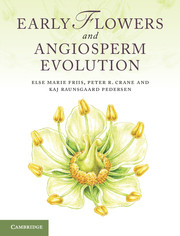Book contents
- Frontmatter
- Contents
- Preface
- 1 Introduction to angiosperms
- 2 The nature of the angiosperm fossil record
- 3 The environmental context of early angiosperm evolution
- 4 Stratigraphic framework and key areas for Cretaceous angiosperms
- 5 Angiosperms in context: extant and fossil seed plants
- 6 Origin and age of angiosperms
- 7 Phylogenetic framework and the assignment of fossils to extant groups
- 8 Fossils near the base of the angiosperm tree
- 9 Early fossil angiosperms of uncertain relationships
- 10 Early fossils of eumagnoliids
- 11 Fossils of monocots
- 12 Fossils of eudicots: early-diverging groups
- 13 Fossils of core eudicots: basal lineages
- 14 Fossils of core eudicots: rosids
- 15 Early fossils of eudicots: asterids
- 16 Patterns of structural diversification in angiosperm reproductive organs
- 17 History and evolution of pollination in angiosperms
- 18 History and evolution of dispersal in angiosperms
- 19 Vegetational context of early angiosperm diversification
- 20 The accumulation of angiosperm diversity
- References
- Index
18 - History and evolution of dispersal in angiosperms
Published online by Cambridge University Press: 07 September 2011
- Frontmatter
- Contents
- Preface
- 1 Introduction to angiosperms
- 2 The nature of the angiosperm fossil record
- 3 The environmental context of early angiosperm evolution
- 4 Stratigraphic framework and key areas for Cretaceous angiosperms
- 5 Angiosperms in context: extant and fossil seed plants
- 6 Origin and age of angiosperms
- 7 Phylogenetic framework and the assignment of fossils to extant groups
- 8 Fossils near the base of the angiosperm tree
- 9 Early fossil angiosperms of uncertain relationships
- 10 Early fossils of eumagnoliids
- 11 Fossils of monocots
- 12 Fossils of eudicots: early-diverging groups
- 13 Fossils of core eudicots: basal lineages
- 14 Fossils of core eudicots: rosids
- 15 Early fossils of eudicots: asterids
- 16 Patterns of structural diversification in angiosperm reproductive organs
- 17 History and evolution of pollination in angiosperms
- 18 History and evolution of dispersal in angiosperms
- 19 Vegetational context of early angiosperm diversification
- 20 The accumulation of angiosperm diversity
- References
- Index
Summary
In addition to great diversity in floral structure and modes of pollination, extant angiosperms also exhibit astonishing variety in fruit and seed morphology. This variety reflects a great range of different modes of dispersal as well as other aspects of dispersal biology. Dispersal and establishment is a key phase in the plant life cycle. Dispersal allows new populations to be established and new habitats to be colonised. It therefore has an important influence on the structure of plant populations. The evolution of angiosperm dispersal modes may have had important consequences for large-scale patterns of angiosperm evolution.
As with pollination, dispersal in angiosperms and other seed plants may be abiotic or may involve interactions with animals. However, in contrast to pollination, where pollen is carried from flower to flower, in dispersal the destination for the propagule is generally much less tightly constrained (Wheelwright and Orians, 1982). The potential reward for the disperser is also available only at the outset, rather than also on completion. The evolutionary dynamic is therefore different. As a result, co-evolution between plants and their dispersers may be much less specific than is often the case for pollination (Wheelwright and Orians, 1982). Co-evolution is more likely to be ‘loose’ rather than ‘tight’ (Herrera, 1985; Fleming, 1991).
- Type
- Chapter
- Information
- Early Flowers and Angiosperm Evolution , pp. 445 - 460Publisher: Cambridge University PressPrint publication year: 2011

